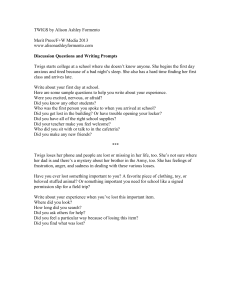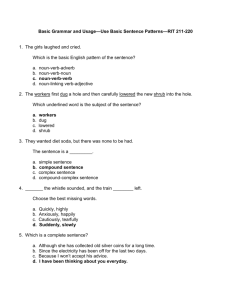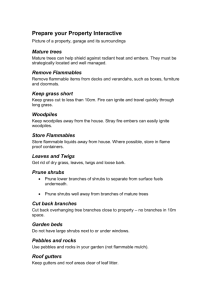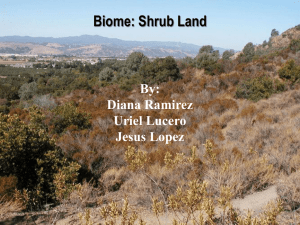Deerbrush G.
advertisement
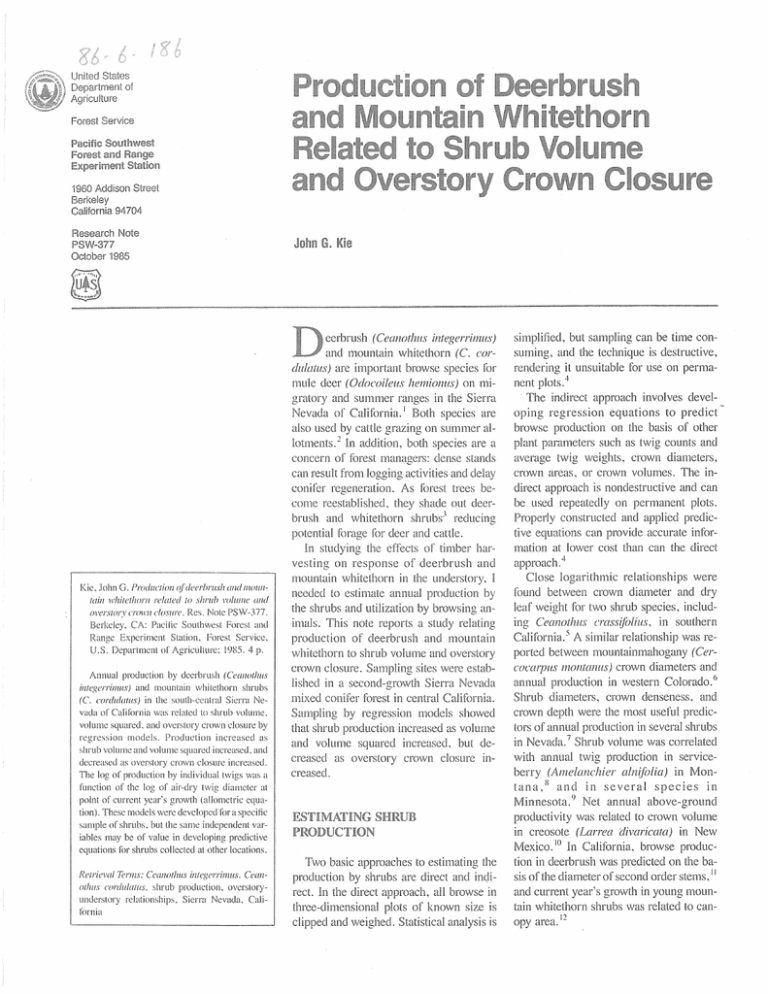
United States
Department of
Deerbrush
Agriculture
Forest Service
Pacific Southwest
Foresf and Range
ExperimenfiStation
1960 Addison Street
Berkeley
California 94704
Research Note
PSW-377
Odober 1985
John G. Kiie
eerbrush (C~c~rlorhus
it~tl~errimris) si~nplified,but sarngling can be time conand nllountain whitethorn (C. (.or- suming, and the technique is destructive,
cjlrkclttrs)are important browse species for rendering ihlnsuitable for use on permar11ule deer (Ock~c.oi/czr.s
hernial-ztis) on mi- nent plots.'
The indirect approach involves develgratory and sul-nmer ranges in the Sierra
oping
regression equations to predict'
Nevada of California.' Both species are
browse
pmductlon on the basis of other
also used by cattle grazing on snmrner alplant
pararlleters
such as twig counts and
lotlnents.' In addition, both species are a
average
twig
weights,
crow11 diameters,
concern of bm-est fmranagers: dense starmds
crown
areas,
or
crown
volumes. The incan result from lcpgging activities and delay
direct
approach
is
nondestructive
and can
conife"epegeneration. As fcxest trees kebe
used
repeatedly
on
pernnanent
plots.
ccxsre reestablished, they shade out deerPrcjperly
constructed
and
applied
predicbrush and whitethorn shrubs' reducing
tive equations can provide accurate inforpotential forage for deer and cattle.
In studying the effects of timber liar- mation at lower cost than can the direct
vesting on response of deerbrush arrd approach.
Close logarithmic relationships were
llrrorrntain whitetheprn in the understory, I
needed to estirlrate annu~nlpmduction by fotind between crown diameter and dry
the shrubs and ~"eiizationby browsing an- leaf weight for tw s h u b species, includc*mssqi>lius,
in southern
inrals. This note reports a study relating ing Ceni~sl-h~as
. ~similar lal lion ship was reproduction of deerbrush and mountain ~ a l i f o r n i aR
whitethorn to shrub volurme and overstory ported between mountainrnahogany (CPP-inonkclnus) crown dlarlileters and
crown closure. Sa~~aplirag
sites were estab- ('OC'CIFI?US
lished in a second-growt1-r Sierra Nevada annual production in western ~olorado.'
mixed conifer forest in central California. Shrub diameters, crown denseness, and
Sae~lplingby r-egression rnodels showed crown depth were the most useful predicaha shrub production incre~isedas voiunne tors of annual production in several sbubs
and volulne squtired increased, but de- in ~ e v a d aS. h~u b volume was corp-elated
with annuaI twig production in servicecreased as svers"kv crown closure inberry (AtneEntzckzier altz@licr) in Moncreased.
tuna,%und in several species in
~ i n n e s o t a . ' Net annual above-ground
productivity was related to crown volunle
ESTIMATING S N R m
in creosote (hi-readivaricnfcx) in New
PRODUCTION
Mexico. 111 Califsrnia, browse producTwo basic approaches to es"lrmating the tion in deerbrush was predicted on the baproduction by shrubs are direct and indi- sis of the diameter of second order stems,
rect. In the direct approach, all browse in and current year's growth in young mounthree-din~ensionr-nlplots of knov~nsize is tain whitethorn shrubs was mlated to canclipped and weighed. Statistical analysis is opy area. "
'
Kie, John 6;.Pr.oclrrc,ttono# rl(>ci.i>r-rr,sh
lrrtcl morarirtbz ,r*!zirc~thoriti . ~ ' ( l ! f ~toj ~s/~riiO
i
vo111t~1(>(lit(/
otrr,ctory cmr;w c~io,~~au.
Res. Nore PSW-377.
Berhcley, CA: Pacific Southwest Forest ancl
Range Exper~~nent
Station, Forest Service,
U.S. Depamcilt of Wgric~~lttire;
1985. 4 p.
Annual productior~by deerhrilsh (Coruiothrir
tizic1<yerrunir,t)
and mouimtaln wtlitethorrl .;hrulss
(C. c~or(hkrrrw)in the icjnth-central Slorra Ne~
vada of Caliiorn~awas relatcd to \ h r ~ l ivc>lurne,
volume squared. and overslory clown clo\ure by
regres.;torr models. Production increaseci as
ihrub volume and volurne squared ~ncreased,and
dccreasccl as ineratory crown closure ~ncreased.
The log of prc;ductlon by individual twigs was a
Ihncriot~of the log of air-dry ttvig dlanncter at
point trf current year"s growth (ailor-metrlcequation). These mcldel: were developed ihr a specific
samplc of shrubs, but the same Independent variables rnay be of value in developing pl-edtctive
equatlolls k)r shrubs collectecl at other locations.
Xctr-rrr~alE~rmj:Ct~cmotlzzoir~ic::.cr-rirrtro,Ccrrrtrttlrio i,ord~rltaiiw,shrub pmdiaction, overstorytinderdory relationships, Sierra Nevada, Californta
"'
'
Measuremer~tsof twig diameters at
point of current year's growth and aqoint
of browsing can be used to estimate shrub
biomass removed by browsing animal^.^ A
random sarnple of such browsed twigs,
along with an esti~nateof browsed versus
unbrowsed twigs, can be used to estimate
utilization of current year's growth for an
entire shrub." Using twig weight and diameter information can result in more accurate utilization estimates than before and
after twig length measurements, or simple
counts of browsed and unbrowsed
twigs. l4.I5
STUDY AREA AND METHODS
The study area was located on the southeast flank of Dinkey Mountain, in the
Sierra National Forest east of Fresno, California (37" 00'N,119" 08' W). Sarnpling
sites were located at about 1700 m elevation in second-growth Sierra Nevada
mixed conifer forest, on Shaver series soils
(Pachic Ultic Haploxerolls) characterized
by gentle to moderately steep slopes ( 1550 percent). Overstory tree species included white fir (Abies concolor), ponderosa pine (Pinus ponderosa) , sugar pine
(P lambertiana), and incense-cedar (Libocedrus decurrens). The study sites represent the upper elevational limit for
deerbrush and the lower limit for mountain
whitethorn in the southern Sierra Nevada.
The sites were used by mule deer primarily
during spring (May-June) and fall (October-November) migration each year.
Cattle had access to the sites from July to
September.
At four sites, a total of 30 deerbrush
shrubs (12 in 1982, and 18 in 1983), and
30 mountain whitethorn shrubs (10 each in
1981, 1982, and 1983) were selected.
They represented the range of shrub volunne and overstory crown closure encountered in the study area. Shrub height, the
largest shrub diameter, and diameter at
right angles to largest shrub diameter were
measured to the nearest 0.01 rn. Shrub
volume (VOL) was calculated from the average of the two diameters with the formula for a cylinder. Crown closure for
overstory trees was obtained by taking a
photographic slide with a 35-mm camera
and a 28-nnm wide-angle lens (75" field of
view), held 1.5 m above the ground. The
resulting slide was projected on to a grid
sf 150 points and the percentage of points
intersecting tree boles, branches, or crown
was recorded as overstory crown closure
(CROWN).
Each fall, all leaves and the current
year's growth of twigs available to browsing ani~nals(within 0.6 m from the edge
of the shrub and not over 1.5 m above
ground) were sampled. To reduce sampling time, only portions of the shrubs
were clipped. Four randomly located,
nonoverlapping wedges were delineated
on each shrub, and only the current growth
within these wedges was clipped. The angle of the wedge (range 10-90") chosen
was a function of the. size of the shrub.
Larger angles were used on smaller
shrubs. About one-third of all shrubs were
small enough that each wedge subtended
a full 90 degrees, and the entire shrub was
clipped. If the wedge angle was less than
90 degrees, the resulting forage weights
were expanded to represent a full quarter
of the shrub. Forage weights from each
wedge were combined to arrive at a value
for the shrub as a whole.
A sample of individually tagged twigs
on shrubs not clipped as part of this study
indicated that both deerbrush and whitethorn ceased twig elongation by late August. To avoid missing some of the current
year's growth because of leaf Pdl, deciduous deerbrush shrubs were clipped in late
August and early September each year.
Evergreen whitethorn shrubs were not
clipped until October each year. Twigs and
leaves were separated, oven-dried at 5560 "C for 48 hours, and weighed to the
nearest 0.1 g. The largest basal stern of
each shrub was sectioned for age deterrnination.
To develop predictive equations for individual twigs, leaf and twig component
weights for 862 unbrowsed deerbrush
twigs (462 in 1982, 400 in 1983) and 787
unbrowsed whitethorn twigs (400 in 1981,
and 387 in 1982) were measured to the
nearest 0.01 g. In addition, air-dry diarneter at point of current year's growth
(ADD) was recorded to the nearest 0.05
Inm.
Data for all years and sites were pooled.
Predictive equations were developed by
using multiple linear regression (Pl R) and
all possible subsets reg~ssion(P9W) prograrns available with BMI3P.I6 For variables expressed as percentages, arcsin
transforinations were used.
RESULTS AND DISCUSSION
Shrub Production
The deerbrush shrubs in this study averaged 7.67 years of age (range 2- 14
years). 9.33 d in volume (range 0.5745.87 mi), and grew under an average
overstory crown closure of 33 percent
(range 0-72 percent). The whitethorn
shrubs averaged 9.63 years of age (range
5-20 years), 18.59 rn3 in volume (range
0.1 1- 103.34 m3), and grew under an average overstory crown closure of 27 percent (range 6-71 percent).
Oven-dry weight of twigs (TWIGS) and
oven-dry weight of leaves (LEAVES), in
both deerbrush and mountair1 whitethorn,
increased with increasing shrub age and
volume. Combined twig and leaf weights
(TOTAL) also increased as a function of
shrub volume (VOL) ('$8. I). These increases did not appear to be linear, however, showing a convex-downward
functional relationship. T W I G S ,
LEAVES, and TOTAL in both deerbrush
and whitethorn also tended to decrease
with increasing overstory crown closure
(CROWN) (fig. I).
To determine the best subset of independent variables with respect to precision
of estimates, I used all possible subsets
regression. Separate equations were developed for TWIGS, LEAVES, and TOTAL for both species, using AGE, YOL,
VOL', and CROWN as independent variables. The criterion used to select the best
subset was the lowest Mallow's CP
value. l 7
In deerbrush, the best subsets for all dependent variables (TWIGS, LEAVES,
and TOTAL) consisted of the independent
variables W t ,WL', and CRO?NN (mble I). In each case, the b value for VOL'
was negative (which accounted for the
convex-downward shape of the production-volurne curve), as was the b value for
CROWN (indicafng decl-easing production as overstory crown closure increased).
For whitethorn LEAVES, the best subset of independent variables was again
VOL, YOL', and CROWN (tal7le I).
Howevel; the best subset for whitethorn
TWIGS was VOL and AGE,and the best
subset for TOTAL was VOk and CROWN.
But the use of the expanded model (including VOL, VOL', and CROWN as in-
12 -
:
DEERBRUSH
Models were constructed for the production, by individual twigs, of twigs
alone (TWIGWT) , leaves (EEAFWT) ,
and twigs and leaves combined (TOTALW) as hnctions of ak-dry diameter
at point of current year's growth (ADD).
TOTALW was related to ADADD in both
deerbrush and mounhin wbtethorn in a
convex-upward function Cjig. 2). The relationskp was portrayed by the allornetric
equation Y = dlb.Natural log transformations were used and least squares solutions found for the models:
EN(U) = LN(a) bLN(X),
where separate equations were calculated
for LN (TWIGW), LN(LE
Lfd(T0TALW) as dependent variables ,
and %N(I.laDD) was used as the independent variable.18 Direct conversion back to
untransforrned u ~ t iss biased and requires
that the antilog of the esfmated Y values
be multiplied by a correction factor (CF):
CF = exp((~,.3~12),
where S,,, is the standard error of the estimate for the regression model. 18. l 9
Models developed for deerbrush and
mountain whitethorn twigs resulted in r?
values shown (table 2). Standxd errors of
the estimates are provided for calculation
of the correc"non factor necessary to convert back to untrmsformed scales.
+
WHITETHORN
Figure '1-Relationships between oven-dry
weighmf current year's production (TOTAL),
shrub volume (VOL), and overstory crown closure (GROWN) in deerbrush and whitethorn
shrubs. Response surface is in the form of TOb2VOL2 $CROWN,
TAL = bo + b,VOL
with coe~icien6as s h o w in table I. Points are
connected to response surface with vertical
lines.
+
+
dependent variables), although not adding
much to It2, did not result in large increases in CP (TWIGS CP = TOTAL CP
= 4.00) (table I). Therefore, the pwarnelers for the full model are given (table I).
Measuremnts of VOL and CROWN are
relatively easy to o b t ~ and
n do not require
destruc~onof the shrub, ud&e AGE.
Utilization by Browsing A
Individually tagged twigs on both deerbrush and mountak whitethorn shrubs indicated &at ~ g r a t h gdeer browsed about
25 percent of the new twigs before midJune, as they were starting to elongate.
DEERBRUSH
10 -
0
1
0
1
2
3
1
2
3
ADD
6
4
5
6
(mm)
Figure 2-Relationship between oven-dry
weight of current year's production (TOTALW)
and air-dry diameter at point of current year's
growth (ADD) in deerbrush and whilethorn
Wigs. Plotted line is in the form of LRI(T0TALW)
= LN(a) + bLN(ABD), with coefficients as
shown in table 2. For clarity, not all points with
ADD less than 3 mrn are plotted.
The usual shub response was for a remainkg lateral twig to take over terrninal
growth. This early browsing by deer did
not appear to affect final production estimates, but further research is needed.
+
IkArcsintra~lsfomed(degrees)
5
WHITETHORN
Table 1-Regressioiz coejicie~ztstrrzd tlzeir standard errors jbr the sirbsets of equutioi~s(TWIGS, LEAVES, TOTAL) = b,, b,VOL + b2v0L2
errors of tlze estinzates (S, ,); squared multiple con.ektrion coeficients (R?; atzd Meillow's CP ~11~ie.r;
fbr cl'c.erbrush cr~zcl~dziret/zornslzriibs
Whitethorn (n = 30 shnths)
TWIGS (g)
LEAVES (g)
TOTAL (g)
4
(mm)
ADD
+ b,CROWN; s t c ~ ~ ~ l ~ i r c i
290.98
251.37
542.35
22.12 ( t 7.09)
41.53 ( t 9.19)
63.65 ( t15.30)
-0.449 (20.173)
-0.464 (20.224)
-0.913 (20.374)
-6.14 ( 2 1.78)
-6.12 ( 2 2.30)
- 12.26 ( 2 3.84)
140.79
182.43
303.90
0.46
0.69
0.61
3.04
4.96
3.84
711.12
736.08
1447.20
35.98 (i- 9.41)
34.35 ( t 9.95)
70.33 ( t15.87)
-0.040 (20.102)
-0.197 ( 2 0 . 108)
-0.236 (20.172
- 12.15 ( 2
- 12.07 ( 2
380.86
402.53
0.86
0.64
4.00
4.02
6.61)
6.98)
Table 2-Regression coeficietrts and flzeir sranchrci errors for the equations LPd(TWIGVV7: L E A F W 7'0TALWT} = m j u ) -i- blfl (',UID),bvhr~z.ADD i~ f r t r i ~~lir-tby~ C I I P Z~ilbtlli~tr~j
~ I P ~ ; c m r s ofdte rsrinratcs (S, ,I;
and squarecl correllttinn coe#ic*ielzts (r2);jhr. e~eerbr~~stl
cmd b$?hi?etl70rfz
trvig~
Deerbmsh (n = 862 twigs)
LN(TWIGWT) (g)
LN(LEAWF) (g)
LN(T0TALWT) (g)
Whitethorn (n = 787 twigs)
LN(TWICWT) (g)
LN(LEAFWT) (g)
LN(T0TALWT) (g)
-3.614
- 2.967
-2.597
Little additional summer use of sample
shrubs was observed duri-ig this study.
However, at higher elevations on deer
summer ranges, whitethorn leaves are an
import ant component in deer diet s.
Whitethorn twigs become s h a ~ l yspinescent by late June, and deer normally pick
individual leaves off the twigs. Similarly,
because sheep often strip leaves from
snowberry (Symphoricarpos or-eophilus)
twigs, percentage of twigs browsed did not
accurately estimate bmwsing intensity.
Therefore, the use of a model based on.leaf
weight as a hnction sf twig dianneter was
rrecommended.
'
CONCLUSIONS
3.296 (20.062)
1.994 (20.061)
2.729 (20.054)
0.577
01566
0.508
0.78
0.58
0.76
undoubkdly vary as a hnction of latitude
and elevation. Whitehorn shhiibs growing
at higher elevations, for example, are
likely to produce less during the shorter
growing season and leaves may be smaller.
However, measuren~entsof s k u b volume
and overstory crown closure can be used
to develop equations for shrubs growing
elsewhere.
S k ~ b s particulzly
,
those growbla47~gin
more xeric locations, often show annual
differences in. production related to precipitation and available moisture patterns.19 Prodtlclion per shrub and
production per twig did not differ between
yeas in this study; howeverr, the study was
not designed to test for such differences.
Also, precipihtion, primarily snowfall in
winter9was normal or above normal durk g the 3 yeas of $hi?;study. Production
would likely be lower during drought
years.
Rsduction of twigs and leaves by deerbmsh and mountain whitehorn shxbs was
a hncfon of s h b volume md overstoy
crown closure. Net pmduction, defined as
the annual growth available to browskg
animals, increased as s h b volume increased. Increasing crown closure was reBated to decreased producf on of leaves and
I thank Laura Bond, Dawn Freese, Carol
DiGiorgio, Kiln Lathrop, Steve Myler, Patricia Page,
twigs.
I ~ a p r e v i o u s s ~ y , b a s a l s t e m d i a m e - Jeannette Peyton, Kathy Purcell, Pauline
ters from 60
stems in deerbrush
to
predictav@
ifor
leaf weight and totat weight per secondary
stem. l1 Using that technique, several basal
stem diasn~eterrneasurenlents would be requked for each shrub. S h u b height and
dian-aetermay be o b t ~ n e dfrom data taken
for other pulposes' and would yield the
necessary estimate of shrub
the
models presented here.
Models presented here were developed
for a specifc sample of
and should
not be used to estimate production by
shrubs in other areas. Growth patterns of
both deerbrush and mountain whitethorn
United States and Cmzda. Washington, DC:Sm.
Am. For,; 9980: 118-Ilia.
"uthe~ford, M.C. Plant-based tecltniquesfor determinirzg available browse a.d browse utilhtion: a
review. The Bot. Rev. 45:203-228; 1979.
Kituedge, Joseph. Some qtkantitative ref'ationsof
Ecology 26:70-73; 1945.
foliage in the cl~ad>arml.
~ e d i nDean
,
E. Plzysical site factors influenciq
atznual ~~roductiorz
of true mouielainmahogatzy, Gercocapus montmus. Ecology 42 :454-460; 1963.
Dean, Sheila; Burbardt, J, Wayne; Meeuwig,
Richard 0. Eslimatigl: twig andfofiqge biomss of
sagebrush, bit~erbrush,arzd rcsbbilbrusbz in the Great
Basin. J. Range Manage. 34:224-227; 1981.
%yon, &. Jack. Estimatiszg mig pr&ctiorz ofserviceberry frorpz crown volurrzes. J. Wildl. Manage.
32: 115-119; 1968.
Peek, James M. Relation ofcanopy area arzcl volume t* ~ o d u c h $tjlree
n
w o d species.
~
Ecology
S"1~098-"0'; 1970.
Burk, J.13.; Dick-Peddie, W.A. Gmparative
qfLarrea divaricata Caa o,z tilree geem~rphicsu*ces in southern N ~ W~ e r i c o Ecology
.
54: 1094- 1302; 1973.
" Bartolome, James W.; Kosco, Barbara H.Es-
'
b"Wsep"duC"o"
by
'CeMoLUs
integerrims). J. Range Mmage. 35671-472; 1982.
" Eberlein, Gary P.Estimating growth of young
mountain wlzitethorjz s t ~ r ~ bRs .~ SNote
.
psw-357.
Berkeley, CA: Pacific Southwest F o ~ s em d Range
Experiment Station, Forest Service, U.S. Departm n t of Agriculhrre; 1982. 3 p.
Ferguson, Robert B.; Masden, Michael A. Estipnoting overtt~incerbitterbruslz uuzilizationfiomfitjig
diameter-lenglh-t+jeigI~t
relatiorrs. J. Wmge Mcmage.
30:231-236; 197'7.
I" Jensen, Charles H .;Urness , Philip J . Estctb.lisIzirzg browse uliJization&onz twig diameters. J . Wmge
Manage. 34:113-118; 1981.
IS Ruyle, G.B.; Bowns, James E.; Schiundt, Al B;:
Estinzating snowberry (Symphoricqos oreophilus)
utilization by sheep from twig diameter-rveighf relations. J. Range Manage. 36:472-474; 1983.
l6 Dixon, $a! J., chief editor. BMDP statistical so&
Mare. Berkeley: Univ. Calif. Press; 1981. 725 p.
l7 Neter, John; V\rasserrnao, William, Applied linear statistical models. Homewood, IL: Richard D.
kwin, Inc.; 1974. 842 p.
" Baskerville, G.L. Use oflo,"arithmic regression
"
ktizees~irnaiionofplmtbion~ass.Cm.J.ForRes.
END NOTES AND mFEmNCES
2:49-53; 1972.
~ l9~Sprugel,
~
~ D.G.
l , Correctills
~ fir bicrs
~ in log-trapzs~
formed nl/onuerric equniiorms. Ecology 64:209-2LO;
1983.
20
Mindschy, Robert W.Eflects ofprecipitation variance on anntral grottjth of 14 species of browse
shrubs irz soutizeasfem Orego~z.J. Range Manage.
35:265-266; 1982.
' Leopold, A. Starker; Kiney, T h e ; McCain.
Randal; Tevis, Lloyd, Jr. The Ja~vbonedeer ired.
Ga~lleBull. 4. Sacramento, 638: Calif. Dep. of fish
Game: 1951. 139 P.
Kosco, Barbam H.; Bxtolome, James W G m i
ing mixed con$er Soresis. Calif. Agric. 32(5):5-7;
1978.
Tappeiner, John C. U.Sienn Nevada miled con$er. In: Eyre, EH., ed. Forest cover types of the
The Author:
J O m 6. H E , a research wildlife biologist, is in
charge of the Station's range management research
unit, headquartered at the Forestry Sciences L a b ratory, Fresno, California. He iloids degrees from the
University of California, Berkeley: B.S. (1972) in
Forestry and Conservation, md M.S. (1973) md
Ph.D. (1977) in Wildland Resource Science. He
joined the Forest Service in 1980.
Suverkopp, and Scott Willems for field md labor,ry
jarnes~
~~~~k B ~ ~
Chuck Evans, Barbara Kosco, and George Ruyle for
the review of the nnmuscript; and Chuck Evms for
providing the computer-generated figures.
~
